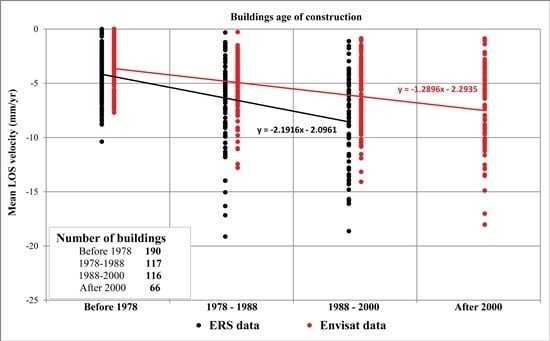PSInSAR Analysis in the Pisa Urban Area (Italy): A Case Study of Subsidence Related to Stratigraphical Factors and Urbanization
Abstract
:1. Introduction
2. Geological and Hydrogeological Setting


3. Available Dataset
3.1. PSInSAR Products
| Satellite | Covered Time Period | Number of Images | Minimum PS Density (PS/km2) | Maximum PS Density (PS/km2) | Standard Deviation | Coherence Threshold | Maximum Subsidence Rate (mm/year) | Maximum Uplift Rate (mm/year) |
|---|---|---|---|---|---|---|---|---|
| ERS 1/2 | 13 May 1992 | 68 | 15 | 350 | ± 0.8 | 0.58 | 22.0 | 2.5 |
| 16 December 2000 | ||||||||
| Envisat | 25 January 2003 | 37 | 50 | 700 | ± 1.2 | 0.68 | 21.1 | 2.8 |
| 12 June 2010 |
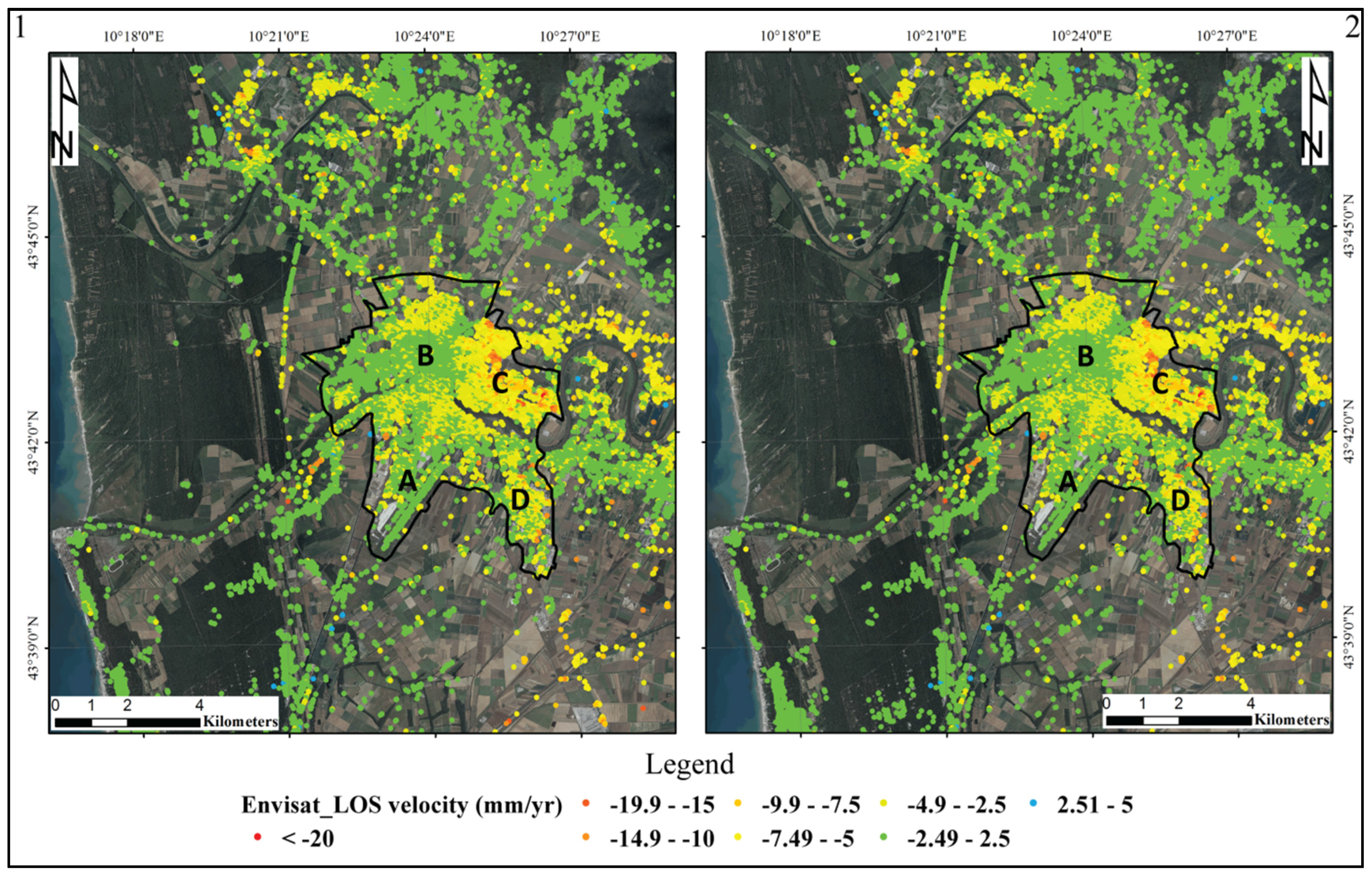
3.2. Borehole Classification and Geotechnical Interpretation
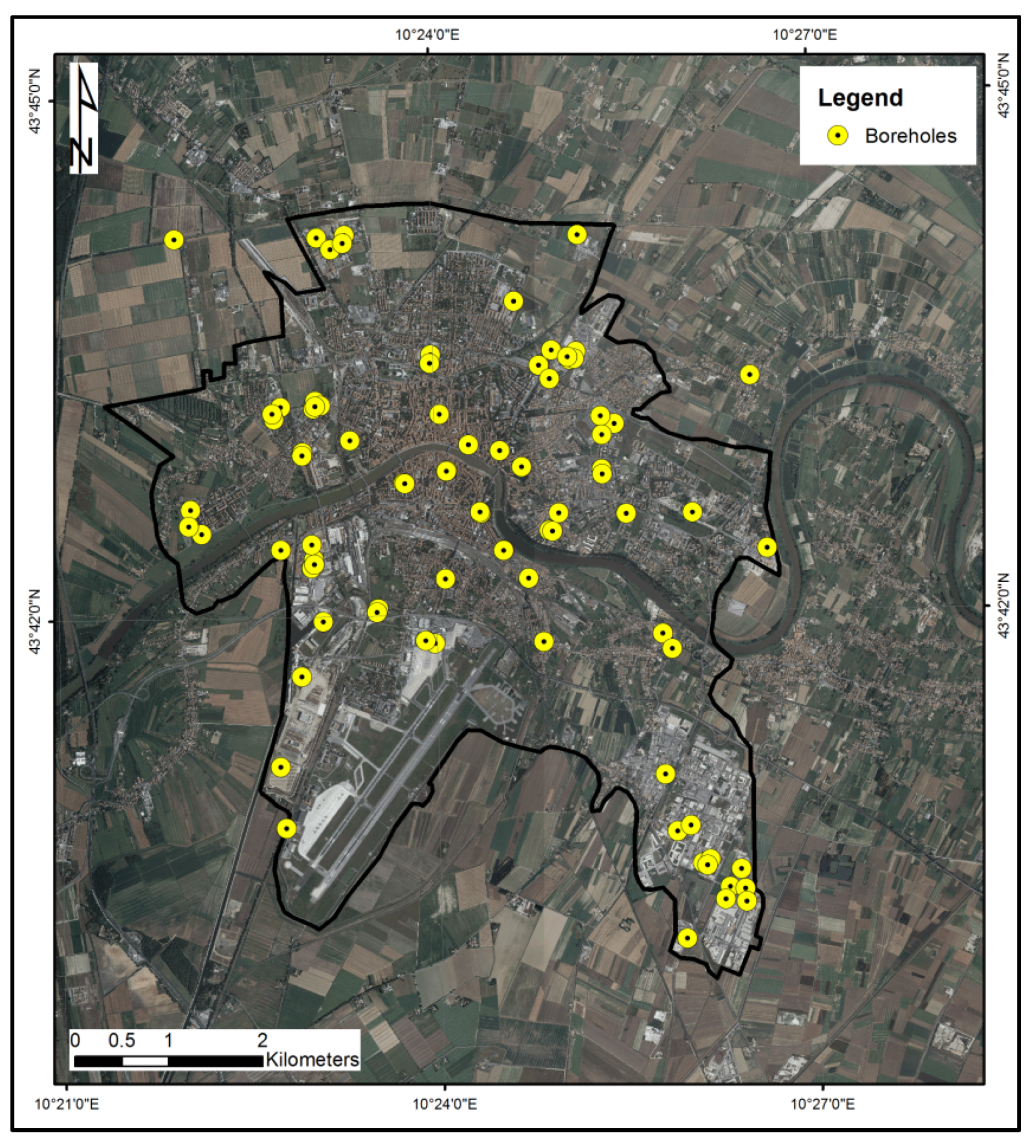
| Class | Facies Association | WN (%) | WL (%) | WP (%) | c′ (kPa) | φ′(°) | Cc | IP | Ic |
|---|---|---|---|---|---|---|---|---|---|
| Unit 1 | Very soft clay | 53.4 ± 12.7 | 69.0 ± 14.1 | 31.3 ± 7.1 | 21.4 ± 12.0 | 4.3 ± 2.3 | 0.5 ± 0.1 | 37.7 ± 8.8 | 0.2 ± 0.1 |
| Unit 2 | Soft clay and silty clay | 44.1 ± 17.0 | 58.6 ± 6.4 | 28.4 ± 5.4 | 22.3 ± 14.1 | 8.1 ± 3.1 | 0.4 ± 0.1 | 28.9 ± 5.2 | 0.4 ± 0.1 |
| Unit 3 | Alternation of clayey silt and sandy silt | 28.5 ± 4.0 | 36.0 ± 6.0 | 22.7 ± 2.1 | 16.4 ± 9.1 | 17.0 ± 8.5 | 0.2 ± 0.1 | 13.3 ± 5.9 | - |
| Unit 4 | Stiff clay and silty clay | 26.7 ± 4.4 | 43.0 ± 14.9 | 25.0 ± 2.9 | 38.3 ± 17.5 | 9.8 ± 3.7 | 0.3 ± 0.2 | 18.5 ± 12.3 | 1.0 ± 0.1 |
| Unit 5 | Silty fine to coarse sand | 22.4 ± 5.0 | - | - | 10.0 ± 8.1 | 28.5 ± 4.2 | - | - | - |
4. Results and Discussion
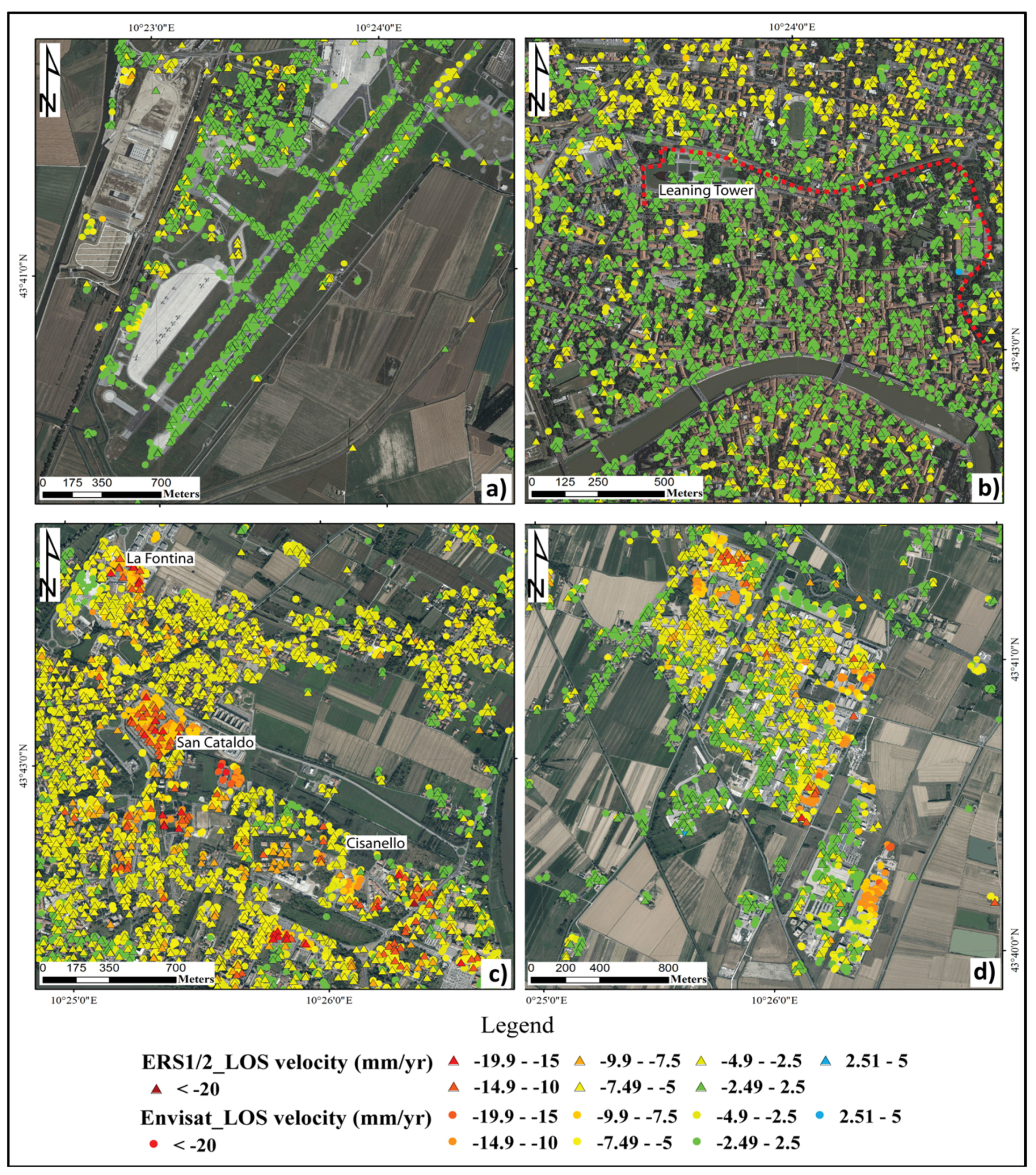
4.1. Land Subsidence in the San Cataldo District
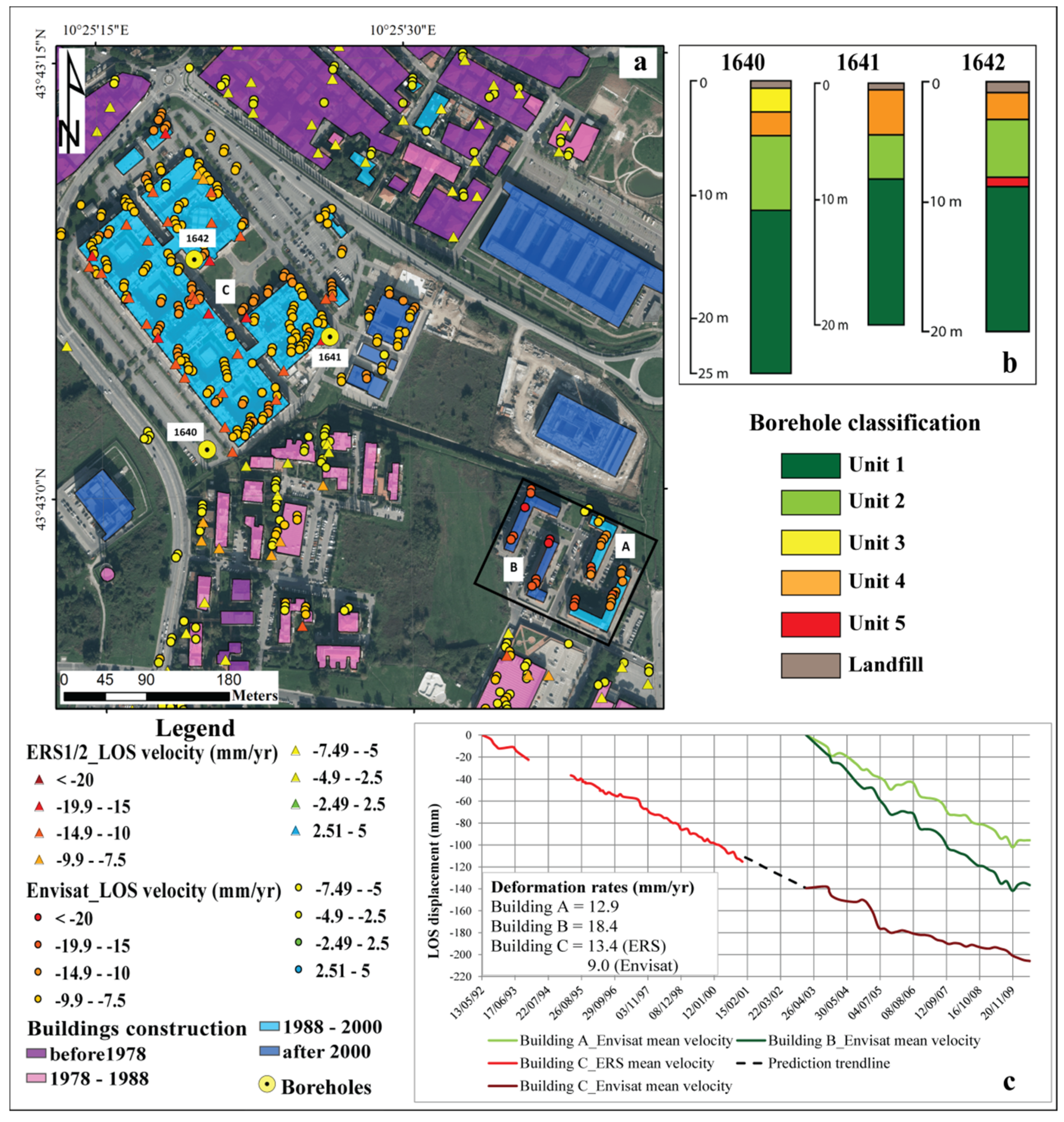
4.2. Land Subsidence in the Ospedaletto District
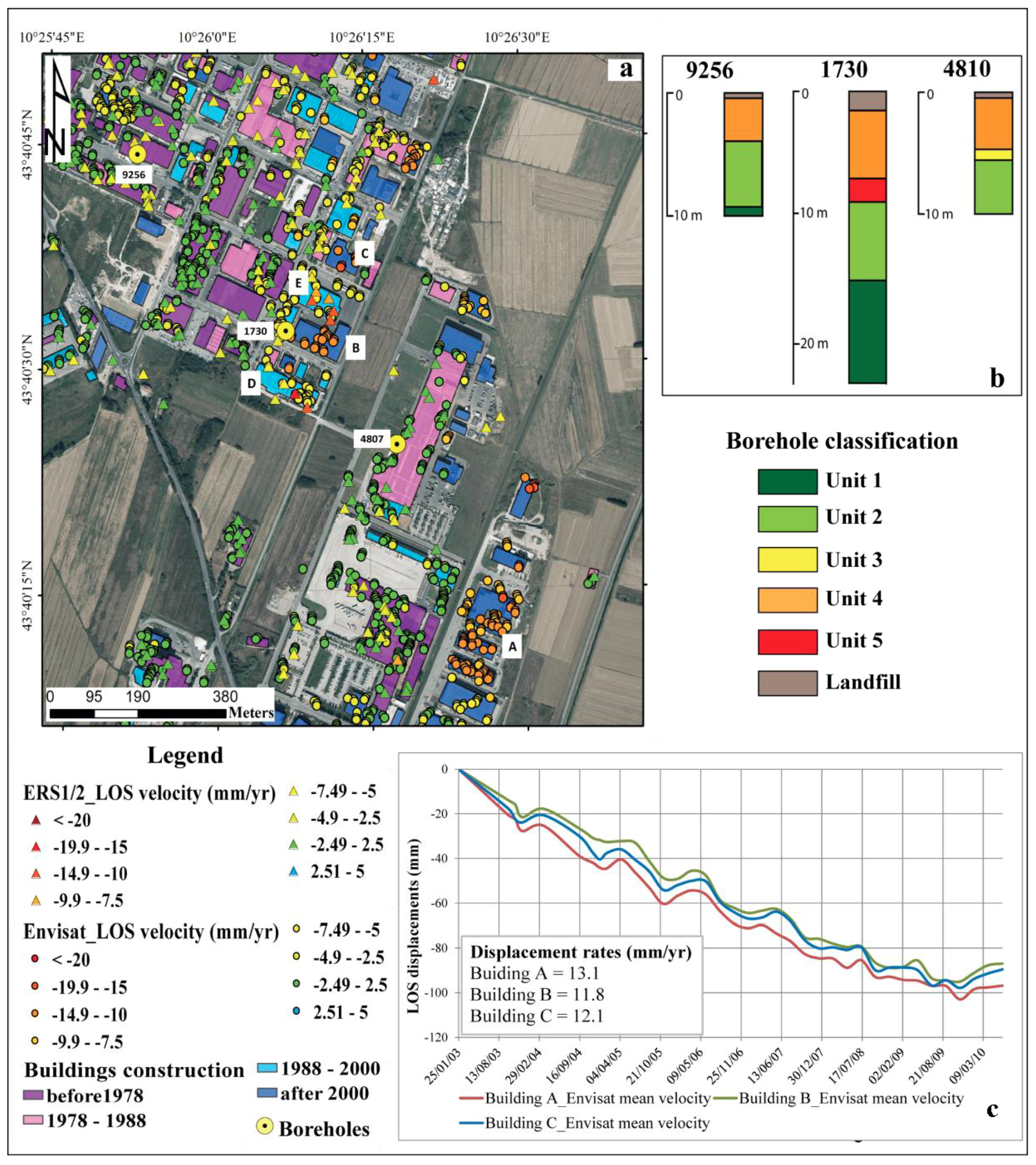
4.3. Comparison between Urbanization and Subsidence Rates
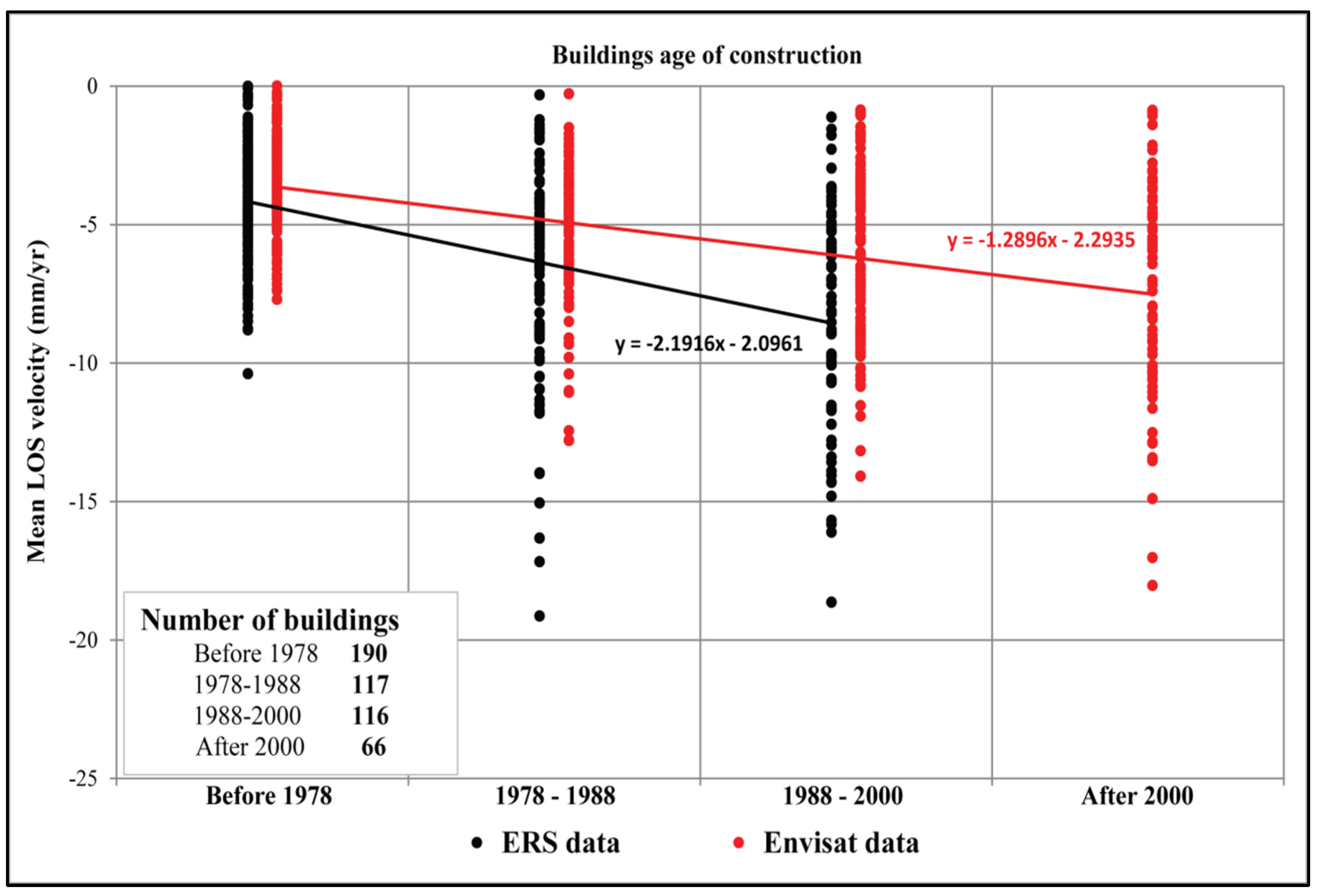
5. Conclusions
Acknowledgments
Author Contributions
Conflicts of Interest
References
- Stramondo, S.; Bozzano, F.; Marra, F.; Wegmuller, U.; Cinti, F.R.; Moro, M.; Saroli, M. Subsidence induced by urbanisation in the city of Rome detected by advanced InSAR technique and geotechnical investigations. Remote Sens. Environ. 2008, 112, 3160–3172. [Google Scholar] [CrossRef]
- Del Ventisette, C.; Solari, L.; Raspini, F.; Ciampalini, A.; Di Traglia, F.; Moscatelli, M.; Pagliaroli, A.; Moretti, S. Use of PSInSAR data to map highly compressible soil layers. Geol. Acta 2015, 13, 309–323. [Google Scholar]
- Teatini, P.; Tosi, L.; Strozzi, T.; Carbognin, L.; Cecconi, G.; Rosselli, R.; Libardo, S. Resolving land subsidence within the Venice Lagoon by persistent scatterer SAR interferometry. Phys. Chem. Earth 2012, 40, 72–79. [Google Scholar] [CrossRef]
- Tosi, L.; Teatini, P.; Strozzi, T. Natural versus anthropogenic subsidence of Venice. Sci. Rep. 2013, 3, 2710. [Google Scholar] [CrossRef] [PubMed]
- Xu, Y.S.; Ma, L.; Du, Y.J.; Shen, S.L. Analysis of urbanisation-induced land subsidence in Shanghai. Nat. Hazards 2012, 63, 1255–1267. [Google Scholar] [CrossRef]
- Dong, S.; Samsonov, S.; Yin, H.; Ye, S.; Cao, Y. Time-series analysis of subsidence associated with rapid urbanization in Shanghai, China measured with SBAS InSAR method. Environ. Earth Sci. 2014, 72, 677–691. [Google Scholar] [CrossRef]
- Chen, B.; Gong, H.; Li, X.; Lei, K.; Ke, Y.; Duan, G.; Zhou, C. Spatial correlation between land subsidence and urbanization in Beijing, China. Nat. Hazards 2015, 75, 2637–2652. [Google Scholar] [CrossRef]
- Qin, Y.; Perissin, D. Monitoring ground subsidence in Hong Kong via Spaceborne Radar: Experiments and validation. Remote Sens. 2015, 7, 10715–10736. [Google Scholar] [CrossRef]
- Dang, V.K.; Doubre, C.; Weber, C.; Gourmelen, N.; Masson, F. Recent land subsidence caused by the rapid urban development in the Hanoi region (Vietnam) using ALOS InSAR data. Nat. Hazards Earth Syst. Sci. 2014, 14, 657–674. [Google Scholar] [CrossRef]
- Abidin, H.Z.; Andreas, H.; Gumilar, I.; Fukuda, Y.; Pohan, Y.E.; Deguchi, T. Land subsidence of Jakarta (Indonesia) and its relation with urban development. Nat. Hazards 2011, 59, 1753–1771. [Google Scholar] [CrossRef]
- Dixon, T.H.; Amelung, F.; Ferretti, A.; Novali, F.; Rocca, F.; Dokka, R.; Sella, G.; Kim, S.W.; Wdowinski, S.; Withman, D. Space geodesy: Subsidence and flooding in New Orleans. Nature 2006, 441, 587–588. [Google Scholar] [CrossRef] [PubMed]
- Polcari, M.; Albano, M.; Saroli, M.; Tolomei, C.; Lancia, M.; Moro, M.; Stramondo, S. Subsidence detected by multi-pass differential SAR interferometry in the Cassino Plain (Central Italy): Joint effect of geological and anthropogenic factors? Remote Sens. 2014, 6, 9676–9690. [Google Scholar] [CrossRef] [Green Version]
- Tang, Y.Q.; Cui, Z.D.; Wang, J.X.; Lu, C.; Yan, X.X. Model test study of land subsidence caused by high-rise building group in Shanghai. Bull. Eng. Geol. Environ. 2008, 67, 173–179. [Google Scholar] [CrossRef]
- Tralli, D.M.; Blom, R.G.; Zlotnicki, V.; Donnellan, A.; Evans, D.L. Satellite remote sensing of earthquake, volcano, flood, landslide and coastal inundation hazards. ISPRS J. Photogram. Remote Sens. 2005, 59, 185–198. [Google Scholar] [CrossRef]
- Joyce, K.E.; Belliss, S.E.; Samsonov, S.V.; McNeill, S.J.; Glassey, P.J. A review of the status of satellite remote sensing and image processing techniques for mapping natural hazards and disasters. Prog. Phys. Geogr. 2009, 33, 183–207. [Google Scholar] [CrossRef]
- Amelung, F.; Galloway, D.L.; Bell, J.W.; Zebker, H.A.; Laczniak, R.J. Sensing the ups and downs of Las Vegas: InSAR reveals structural control of land subsidence and aquifer-system deformation. Geology 1999, 27, 483–486. [Google Scholar] [CrossRef]
- Fruneau, B.; Sarti, F. Detection of ground subsidence in the city of Paris using radar interferometry: Isolation of deformation from atmospheric artifacts using correlation. Geophys. Res. Lett. 2000, 27, 3981–3984. [Google Scholar] [CrossRef]
- Lu, Z.; Danskin, W.R. InSAR analysis of natural recharge to define structure of a ground-water basin, San Bernardino, California. Geophys. Res. Lett. 2001, 28, 2661–2664. [Google Scholar] [CrossRef]
- Farina, P.; Moretti, S.; Colombo, D.; Fumagalli, A.; Manunta, P. Landslide risk analysis by means of remote sensing techniques: Results from the ESA/SLAM project. In Proceedings of the IEEE International Geoscience and Remote Sensing Symposium IGARSS′04, Anchorage, AK, USA, 20–24 September 2004; Volume 1.
- Ferretti, A.; Novali, F.; Bürgmann, R.; Hilley, G.; Prati, C. InSAR permanent scatterer analysis reveals ups and downs in San Francisco Bay area. Eos Trans. Am. Geophys. Union 2004, 85, 317–324. [Google Scholar] [CrossRef]
- Bell, J.W.; Amelung, F.; Ferretti, A.; Bianchi, M.; Novali, F. Permanent scatterer InSAR reveals seasonal and long-term aquifer-system response to groundwater pumping and artificial recharge. Water Resour. Res. 2008, 44. [Google Scholar] [CrossRef]
- Osmanoğlu, B.; Dixon, T.H.; Wdowinski, S.; Cabral-Cano, E.; Jiang, Y. Mexico City subsidence observed with persistent scatterer InSAR. Int. J. Appl. Earth Obs. Geoinf. 2011, 13, 1–12. [Google Scholar] [CrossRef]
- Raspini, F.; Cigna, F.; Moretti, S. Multi-temporal mapping of land subsidence at basin scale exploiting Persistent Scatterer Interferometry: Case study of Gioia Tauro plain (Italy). J. Maps 2012, 8, 514–524. [Google Scholar] [CrossRef]
- Rosi, A.; Agostini, A.; Tofani, V.; Casagli, N. A Procedure to Map Subsidence at the Regional Scale Using the Persistent Scatterer Interferometry (PSI) Technique. Remote Sens. 2014, 6, 10510–10522. [Google Scholar] [CrossRef]
- Kim, J.W.; Lu, Z.; Jia, Y.; Shum, C.K. Ground subsidence in Tucson, Arizona, monitored by time-series analysis using multi-sensor InSAR datasets from 1993 to 2011. ISPRS J. Photogramm. Remote Sens. 2015, 107, 126–141. [Google Scholar] [CrossRef]
- Meisina, C.; Zucca, F.; Notti, D.; Colombo, A.; Cucchi, A.; Savio, G.; Giannico, C.; Bianchi, M. Geological interpretation of PSInSAR data at regional scale. Sensors 2008, 8, 7469–7492. [Google Scholar] [CrossRef]
- Cigna, F.; Del Ventisette, C.; Liguori, V.; Casagli, N. Advanced radar-interpretation of InSAR time series for mapping and characterization of geological processes. Nat. Hazards Earth Syst. Sci. 2011, 11, 865–881. [Google Scholar] [CrossRef] [Green Version]
- Berti, M.; Corsini, A.; Franceschini, S.; Iannacone, J.P. Automated classification of Persistent Scatterers Interferometry time series. Nat. Hazards Earth Syst. Sci. 2013, 13, 1945–1958. [Google Scholar] [CrossRef]
- Bianchini, S.; Moretti, S. Analysis of recent ground subsidence in the Sibari plain (Italy) by means of satellite SAR interferometry-based methods. Int. J. Remote Sens. 2015, 36, 4550–4569. [Google Scholar] [CrossRef]
- Martini, I.P.; Sagri, M. Tectono-sedimentary characteristics of Late Miocene-Quaternary extensional basins of the Northern Apennines, Italy. Earth-Sci. Rev. 1993, 34, 197–233. [Google Scholar] [CrossRef]
- Cantini, P.; Testa, G.; Zanchetta, G.; Cavallini, R. The Plio-Pleistocene evolution of extensional tectonics in northern Tuscany, as constrained by new gravimetric data from the Montecarlo Basin (lower Arno Valley, Italy). Tectonophysics 2001, 330, 25–43. [Google Scholar] [CrossRef]
- Sarti, G.; Rossi, V.; Amorosi, A. Influence of Holocene stratigraphic architecture on ground surface settlements: A case study from the City of Pisa (Tuscany, Italy). Sediment. Geol. 2012, 281, 75–87. [Google Scholar] [CrossRef]
- Pascucci, V. Neogene evolution of the Viareggio basin, Northern Tuscany (Italy). GeoActa 2005, 4, 123–138. [Google Scholar]
- Amorosi, A.; Rossi, V.; Sarti, G.; Mattei, R. Coalescent valley fills from the late Quaternary record of Tuscany (Italy). Quat. Int. 2013, 288, 129–138. [Google Scholar] [CrossRef]
- Aguzzi, M.; Amorosi, A.; Colalongo, M.L.; Ricci Lucchi, M.; Rossi, V.; Sarti, G.; Vaiani, S.C. Late Quaternary climatic evolution of the Arno coastal plain (Western Tuscany, Italy) from subsurface data. Sediment. Geol. 2007, 202, 211–229. [Google Scholar] [CrossRef]
- Amorosi, A.; Pavesi, M.; Ricci Lucchi, M.; Sarti, G.; Piccin, A. Climatic signature of cyclic fluvial architecture from the Quaternary of the central Po Plain, Italy. Sediment. Geol. 2008, 209, 58–68. [Google Scholar] [CrossRef]
- Amorosi, A.; Sarti, G.; Rossi, V.; Fontana, V. Anatomy and sequence stratigraphy of the late Quaternary Arno valley fill (Tuscany, Italy). Adv. Appl. Seq. Stratigr. Italy 2008, 1, 55–66. [Google Scholar]
- Amorosi, A.; Ricci Lucchi, M.; Rossi, V.; Sarti, G. Climate change signature of small-scale parasequences from Lateglacial–Holocene transgressive deposits of the Arno valley fill. Palaeogeogr. Palaeoclimatol. Palaeoecol. 2009, 273, 142–152. [Google Scholar] [CrossRef]
- Lambeck, K.; Antonioli, F.; Anzidei, M.; Ferranti, L.; Leoni, G.; Scicchitano, G.; Silenzi, S. Sea level change along the Italian coast during the Holocene and projections for the future. Quat. Int. 2011, 232, 250–257. [Google Scholar] [CrossRef]
- Rossi, V.; Amorosi, A.; Sarti, G.; Potenza, M. Influence of inherited topography on the Holocene sedimentary evolution of coastal systems: An example from Arno coastal plain (Tuscany, Italy). Geomorphology 2011, 135, 117–128. [Google Scholar] [CrossRef]
- Sarti, G.; Bini, M.; Giacomelli, S. The growth and the decline of Pisa (Tuscany, Italy) up to the Middle ages: Correlations with landscape and geology. Geological setting and urban development of selected Italian towns up to the Middle ages and legacies of ancient problems throughout the ages. II Quaternario Ital. J. Quat. Sci. 2010, 23, 311–322. [Google Scholar]
- Rossi, V.; Amorosi, A.; Sarti, G.; Romagnoli, R. New stratigraphic evidence for the mid-late Holocene fluvial evolution of the Arno coastal plain (Tuscany, Italy). Géomorphologie 2012, 2, 201–214. [Google Scholar] [CrossRef]
- Bruni, S.; Cosci, M. Alpheae veterem contemptlor originis urbem, quam cingunt geminis Arnus et Ausur aquis. Il paesaggio di Pisa etrusca e romana: Materiali e problemi. In Il Porto Urbano di Pisa Antica. La Fase Etrusca. Il Contesto e il Relitto Ellenistico; Bruni, S., Ed.; Silvana Editoriale: Milan, Italy, 2003; pp. 29–43. [Google Scholar]
- Relazione Generale e Allegati Tecnici del Piano Strutturale del Comune di Pisa. Available online: http://www.comune.pisa.it/doc/sit-pisa/nuovo_prg/relaz.htm (accessed on 7 December 2015).
- Massonnet, D.; Feigl, K.L. Radar interferometry and its application to changes in the Earth’s surface. Rev. Geophys. 1998, 36, 441–500. [Google Scholar] [CrossRef]
- Zebker, H.; Villasenor, J. Decorrelation in interferometric radar echoes. IEEE Trans. Geosci. Remote Sens. 1992, 30, 950–959. [Google Scholar] [CrossRef]
- Massonnet, D.; Feigl, K.L. Discrimination of geophysical phenomena in satellite radar interferograms. Geophys. Res. Lett. 1995, 22, 1537–1540. [Google Scholar] [CrossRef]
- Ferretti, A.; Prati, C.; Rocca, F. Nonlinear subsidence rate estimation using permanent scatterers in differential SAR interferometry. IEEE Trans. Geosci. Remote Sens. 2000, 38, 2202–2212. [Google Scholar] [CrossRef]
- Ferretti, A.; Prati, C.; Rocca, F. Permanent scatterers in SAR interferometry. IEEE Trans. Geosci. Remote Sens. 2001, 39, 8–20. [Google Scholar] [CrossRef]
- Italian Ministry of the Environment and Protection of Land and Sea (MATTM). Piano Straordinario di Telerilevamento Ambientale (PSTA); Linee guida per l’analisi dei dati intereferometrici satellitari in aree soggette a dissesti idrogeologici; MATTM: Rome, Italy, 2010; p. 108. [Google Scholar]
- National Cartographic Portal. Available online: http://www.pcn.minambiente.it (accessed on 29 March 2015).
- Tapete, D.; Cigna, F. Satellite-based preventive diagnosis: Use of Persistent Scatterer Interferometry on cultural heritage sites in Italy. In Changing How We View the World, In Proceedings of the Remote Sensing and Photogrammetry Society Conference, University of Greenwich, London, UK, 12–14 September 2012.
- Bellotti, F.; Bianchi, M.; Colombo, D.; Ferretti, A.; Tamburini, A. Advanced InSAR techniques to support landslide monitoring. Math. Planet Earth 2014, 287–290. [Google Scholar] [CrossRef]
- Peduto, D.; Cascini, L.; Arena, L.; Ferlisi, S.; Fornaro, G.; Reale, D. A general framework and related procedures for multiscale analyses of DInSAR data in subsiding urban areas. ISPRS J. Photogramm. Remote Sens. 2015, 105, 186–210. [Google Scholar] [CrossRef]
- Pratesi, F.; Tapete, D.; Terenzi, G.; Del Ventisette, C.; Moretti, S. Rating health and stability of engineering structures via classification indexes of InSAR Persistent Scatterers. Int. J. Appl. Earth Obs. Geoinf. 2015, 40, 81–90. [Google Scholar] [CrossRef] [Green Version]
- Casagrande, A. Classification and identification of soils. Trans. Am. Soc. Civ. Eng. 1948, 113, 901–930. [Google Scholar]
- Rampello, S.; Callisto, L. A study on the subsoil of the Tower of Pisa based on results from standard and high-quality samples. Can. Geotech. J. 1998, 35, 1074–1092. [Google Scholar] [CrossRef]
- Rogers, C.D.F. Types and distribution of collapsible soils. In Genesis and Properties of Collapsible Soils; Derbyshire, E., Dijkstra, T., Smalley, I.J., Eds.; Springer Netherlands: Amsterdam, The Netherland, 1995; pp. 1–17. [Google Scholar]
- Terzaghi, K.; Peck, R.B. Soil Mechanics in Engineering Practice; John Wiley & Sons: Hoboken, NJ, USA, 1967. [Google Scholar]
© 2016 by the authors; licensee MDPI, Basel, Switzerland. This article is an open access article distributed under the terms and conditions of the Creative Commons by Attribution (CC-BY) license (http://creativecommons.org/licenses/by/4.0/).
Share and Cite
Solari, L.; Ciampalini, A.; Raspini, F.; Bianchini, S.; Moretti, S. PSInSAR Analysis in the Pisa Urban Area (Italy): A Case Study of Subsidence Related to Stratigraphical Factors and Urbanization. Remote Sens. 2016, 8, 120. https://doi.org/10.3390/rs8020120
Solari L, Ciampalini A, Raspini F, Bianchini S, Moretti S. PSInSAR Analysis in the Pisa Urban Area (Italy): A Case Study of Subsidence Related to Stratigraphical Factors and Urbanization. Remote Sensing. 2016; 8(2):120. https://doi.org/10.3390/rs8020120
Chicago/Turabian StyleSolari, Lorenzo, Andrea Ciampalini, Federico Raspini, Silvia Bianchini, and Sandro Moretti. 2016. "PSInSAR Analysis in the Pisa Urban Area (Italy): A Case Study of Subsidence Related to Stratigraphical Factors and Urbanization" Remote Sensing 8, no. 2: 120. https://doi.org/10.3390/rs8020120
APA StyleSolari, L., Ciampalini, A., Raspini, F., Bianchini, S., & Moretti, S. (2016). PSInSAR Analysis in the Pisa Urban Area (Italy): A Case Study of Subsidence Related to Stratigraphical Factors and Urbanization. Remote Sensing, 8(2), 120. https://doi.org/10.3390/rs8020120







